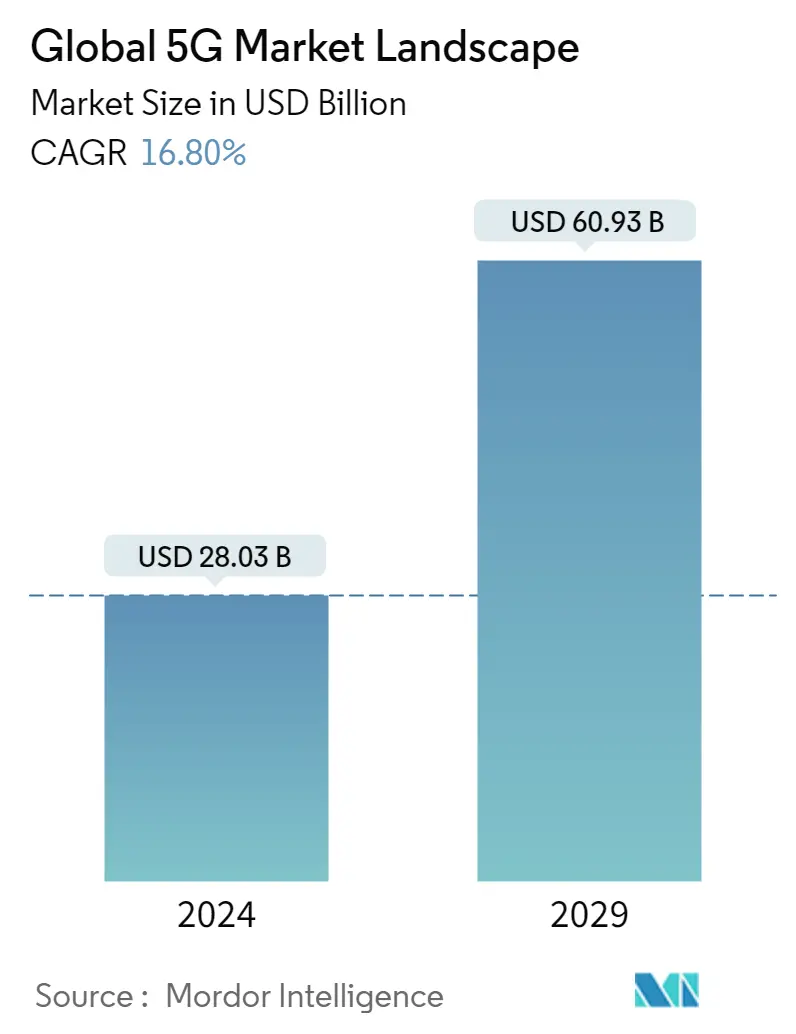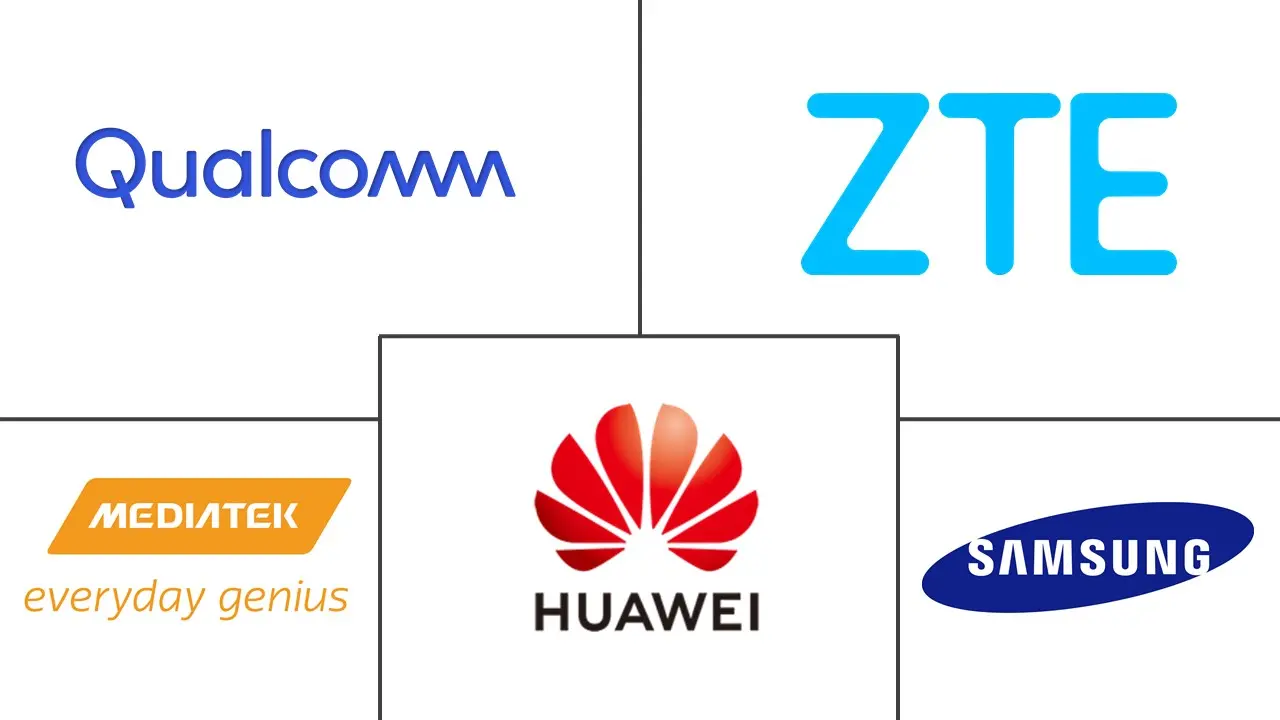Market Size of Global 5G Industry Landscape

| Study Period | 2019 - 2029 |
| Market Size (2024) | USD 28.03 Billion |
| Market Size (2029) | USD 60.93 Billion |
| CAGR (2024 - 2029) | 16.80 % |
| Fastest Growing Market | Asia-Pacific |
| Largest Market | North America |
| Market Concentration | High |
Major Players
*Disclaimer: Major Players sorted in no particular order |
5G Market Analysis
The Global 5G Market size is estimated at USD 28.03 billion in 2024, and is expected to reach USD 60.93 billion by 2029, growing at a CAGR of 16.80% during the forecast period (2024-2029).
With seamless coverage, high data rates, low latency, much better performance, and efficient communications, the 5G network-the next generation of mobile networking standards-is ready to provide an improved end-user experience.
The sphere of smartphones will be one of many things that will be impacted by 5G connectivity. Infrastructural advancements in the Internet of Things (IoT) and Machine-to-Machine (M2M) have, for example, long been constrained by the slow download speeds and latency of 4G. The cumulative effect of any latency will be more significant and observable as more devices are connected to a network and communicating with one another. For instance, augmented reality will eventually enable wearable technology to seamlessly integrate with people's daily lives due to increased speed and bandwidth. Instantaneous communication amongst autonomous vehicles will be quite advantageous for them as well.
Additionally, 5G will dramatically improve smart city services for public security and safety. In instances like a car accident or terrorist attack, real-time analytics of video recordings from public spaces combined with biometric software will be able to identify unsafe circumstances and automatically warn authorities instantly. Contrary to current CCTV systems, 5G-enabled equipment will be able to get updates wirelessly, and data management platforms will link different services. Additionally, 5G connected equipment will be extended to mobile form factors like drones and robots and be able to be installed everywhere there is mobile network coverage, doing away with the requirement for fixed wire.
Furthermore, national governments aiding the expansion of smart city projects is also a key trend in the market. With the support of the Ministry of Housing and Urban Affairs in India, the nation aims to develop 4,000 cities to house a population of 5,00,000 each by 2023. Moreover, in England, Sunderland City Council awarded a 20-year strategic partnership to BAI Communications to design, build and operate next-generation digital infrastructure, including a private 5G small cell network, in October 2021. The New 5G network will realize Sunderland City Council's ambition to be a fully digitally enabled smart city.
Indeed, more than ever, consumers and professionals depend on reliable, fast internet performance after the COVID-19 pandemic, which has increased demand for connectivity. For instance, pandemic restrictions prompted the closure of numerous enterprises and industrial facilities, causing manufacturing processes and supply chains to be disrupted. Remotely controlled devices with 5G communication suddenly became essential. They made it possible for human drivers to operate cranes, drones, and other industrial machinery more quickly, accurately, and from a distance. This is just one of the many ways that 5G could be important for assisting businesses to continue operating and be resilient in the face of any future disruption.
On the flip side, a 5G connection is expected to add multiple layers of complexity to the spectrum due to the all-inclusive nature of services. Limited spectrum availability is a big challenge in the development of 5G. The bandwidth requirements of 5G mean a higher frequency spectrum would be fundamental in delivering high-speed, high-quality connectivity. The 5G standard, which uses millimeter waves, is a lot shorter than the wavelengths 4G uses. The shorter wavelength means a 5G connection can carry much data faster than 4G, but it also means a significantly shorter range. 4G wavelengths have a range of almost 10 miles. 5G wavelengths range about 1,000 feet, not even 2% of 4G's coverage. So, to ensure a robust 5G signal, there is a requirement for many 5G cell towers and antennas everywhere, increasing the setup cost.
5G Industry Segmentation
The Global 5G Market Landscape analyzes the overall market landscape of the 5G industry, with detailed coverage on 5G Adoption (Macro cell-Site, Small cell site), 5G Connections (Mobile Broadband, Fixed Wireless Access, M2M&IoT, Mission Critical), 5G Devices (by form factor(smartphone, CPE(indoor, outdoor), modules, hotspot, laptops, industrial grade ), by spectrum support (sub-6 GHz, mmwave), 5G Chipset (by IC type (RFIC, ASIC, mmWave IC, cellular IC), by Deployment (device, CPE, network infrastructure) and by region.
The market sizes and forecasts are provided in terms of value (USD million) for all the above segments.
| Number of 5G Devices, by Form Factor | |
| Smartphone | |
| CPE (Indoor/Outdoor) | |
| Modules | |
| Hotspots | |
| Laptops | |
| Industrial Grade CPE/Router/Gateway | |
| Other Form Factors(Drones, HMDs, Tablets, TV, Dongles, etc.) |
| Number of 5G Devices, by Spectrum support | |
| Sub-6 GHz | |
| mmWave | |
| Both Spectrum Bands |
Global 5G Market Landscape Size Summary
The 5G technology market is poised for significant growth, driven by its ability to offer seamless coverage, high data rates, and low latency, which collectively enhance user experience. This next-generation mobile networking standard is set to transform various sectors, including smartphones, IoT, and smart cities, by overcoming the limitations of previous technologies like 4G. The integration of 5G is expected to facilitate advancements in augmented reality, autonomous vehicles, and smart city services, such as real-time public safety analytics. The expansion of 5G infrastructure is also supported by government initiatives in countries like India and England, aiming to develop digitally enabled urban environments. The demand for reliable and fast internet connectivity, heightened by the COVID-19 pandemic, further underscores the importance of 5G in maintaining business operations and resilience.
The market landscape for 5G technology is highly competitive, with major players continuously innovating to enhance their offerings. The deployment of 5G is expected to be accelerated in developing regions, where lower-cost devices and new applications are emerging. However, challenges such as limited spectrum availability and the need for extensive infrastructure, including numerous cell towers, pose hurdles to widespread adoption. Despite these challenges, the market is witnessing a surge in 5G subscriptions, particularly in regions like North East Asia and India. Companies like Intel and Hyundai Mobis are integrating 5G into laptops and automotive systems, respectively, highlighting the technology's broad applicability. The market's consolidation is evident as leading firms invest heavily in research and development to maintain their competitive edge.
Global 5G Market Landscape Market Size - Table of Contents
-
1. MARKET DYNAMICS
-
1.1 Market Overview
-
1.2 5G Timeline Overview
-
1.3 Current Adoption Cycle -Forerunners, Adopters & Laggards
-
1.4 Market Drivers (Sustained increase in number of devices & endpoints worldwide| Technological innovations at a component & device level to aid adoption| Key benefits offered by 5G over its predecessors| Growing adoption of virtual networking architecture)
-
1.5 Market Challenges (Standardization delays| Design & Operational Challenges )
-
1.6 Market Opportunities (Anticipated rise in demand from industrial sector| Ongoing efforts towards introduction of 5G in emerging countries)
-
1.7 5G and Beyond -The Path Ahead
-
1.8 Impact of COVID-19 on the 5G Landscape
-
1.9 Key Industry Regulations & Policies
-
-
2. MARKET SEGMENTATION (5G DEVICES MARKET LANDSCAPE)
-
2.1 Number of 5G Devices, by Form Factor
-
2.1.1 Smartphone
-
2.1.2 CPE (Indoor/Outdoor)
-
2.1.3 Modules
-
2.1.4 Hotspots
-
2.1.5 Laptops
-
2.1.6 Industrial Grade CPE/Router/Gateway
-
2.1.7 Other Form Factors(Drones, HMDs, Tablets, TV, Dongles, etc.)
-
-
2.2 Number of 5G Devices, by Spectrum support
-
2.2.1 Sub-6 GHz
-
2.2.2 mmWave
-
2.2.3 Both Spectrum Bands
-
-
2.3 List of Major Vendors
-
Global 5G Market Landscape Market Size FAQs
How big is the Global 5G Market?
The Global 5G Market size is expected to reach USD 28.03 billion in 2024 and grow at a CAGR of 16.80% to reach USD 60.93 billion by 2029.
What is the current Global 5G Market size?
In 2024, the Global 5G Market size is expected to reach USD 28.03 billion.

